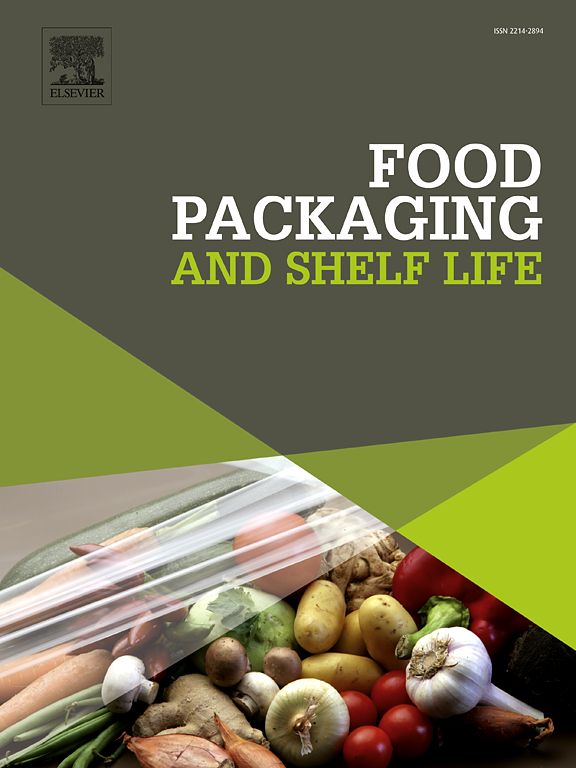Effect of modified atmosphere packaging on storage quality and lignification process of postharvest asparagus (Asparagus officinalis L.)
IF 10.6
1区 农林科学
Q1 FOOD SCIENCE & TECHNOLOGY
引用次数: 0
Abstract
Asparagus (Asparagus officinalis L.) often deteriorates due to intense metabolism that leads to excessive lignification and spoilage. Modified atmosphere packaging (MAP) is beneficial for the preservation of asparagus. In the study, postharvest asparagus was divided into four groups: perforated plastic bags (CK), air MAP (A-MAP), high-oxygen MAP (H-MAP) and low-oxygen MAP (L-MAP). Changes in physicochemical quality, lignification and antioxidant capacity were assessed to determine the optimal treatment group. All MAP groups reduced weight loss and microbial proliferation in asparagus, with H-MAP group best preserving sensory quality. H-MAP decreased lignin accumulation by 20.52 %, which was also reflected in the alleviation of asparagus hardening. Thinner sclerenchyma and fewer vascular bundles were also observed through fluorescence microscopy in H-MAP group. That was attributed to suppressed phenylalamine ammonia-lyase (PAL) and peroxidase (POD) activities that regulated phenylpropanoid metabolism and lignin polymerization. Moreover, CK and A-MAP groups experienced peroxidation, leading to quality deterioration. H-MAP and L-MAP provided early stress protection and later enhanced reactive oxygen species (ROS) clearance, and H-MAP showed the most significant effect. At the end of the storage period, the malonaldehyde (MDA) content of H-MAP group was 2.23 μmol/g (69.04 % of CK group). Therefore, H-MAP offered benefits in preserving the quality of postharvest asparagus by inhibiting lignification and enhancing antioxidant capacity. Future research will focus on further optimization within the H-MAP to determine the optimal ratio of O2 and CO2, and employ omics approaches to elucidate the underlying mechanisms, thereby making it a promising commercial storage solution.
气调包装对采后芦笋贮藏品质及木质化过程的影响
芦笋(芦笋officinalis L.)经常恶化,由于强烈的新陈代谢,导致过度木质化和腐败。气调包装(MAP)有利于芦笋的保鲜。研究将采后芦笋分为4组:穿孔塑料袋(CK)、空气MAP (A-MAP)、高氧MAP (H-MAP)和低氧MAP (L-MAP)。通过评价其理化品质、木质化和抗氧化能力的变化来确定最佳处理组。所有MAP组均降低了芦笋的失重和微生物增殖,其中H-MAP组保存感官品质最好。H-MAP使木质素积累减少20.52 %,这也反映在芦笋硬化的缓解上。荧光显微镜观察到H-MAP组厚壁组织变薄,维管束减少。这归因于抑制苯丙胺解氨酶(PAL)和过氧化物酶(POD)的活性,这些酶调节苯丙胺代谢和木质素聚合。CK组和A-MAP组发生过氧化反应,导致品质恶化。H-MAP和L-MAP具有早期应激保护和后期活性氧清除作用,其中H-MAP的作用最为显著。贮藏结束时,H-MAP组丙二醛(MDA)含量为2.23 μmol/g(为CK组的69.04 %)。因此,H-MAP通过抑制木质素化和增强抗氧化能力来保持采后芦笋的品质。未来的研究将集中于进一步优化H-MAP,以确定O2和CO2的最佳比例,并利用组学方法阐明潜在的机制,从而使其成为一个有前景的商业存储解决方案。
本文章由计算机程序翻译,如有差异,请以英文原文为准。
求助全文
约1分钟内获得全文
求助全文
来源期刊

Food Packaging and Shelf Life
Agricultural and Biological Sciences-Food Science
CiteScore
14.00
自引率
8.80%
发文量
214
审稿时长
70 days
期刊介绍:
Food packaging is crucial for preserving food integrity throughout the distribution chain. It safeguards against contamination by physical, chemical, and biological agents, ensuring the safety and quality of processed foods. The evolution of novel food packaging, including modified atmosphere and active packaging, has extended shelf life, enhancing convenience for consumers. Shelf life, the duration a perishable item remains suitable for sale, use, or consumption, is intricately linked with food packaging, emphasizing its role in maintaining product quality and safety.
 求助内容:
求助内容: 应助结果提醒方式:
应助结果提醒方式:


